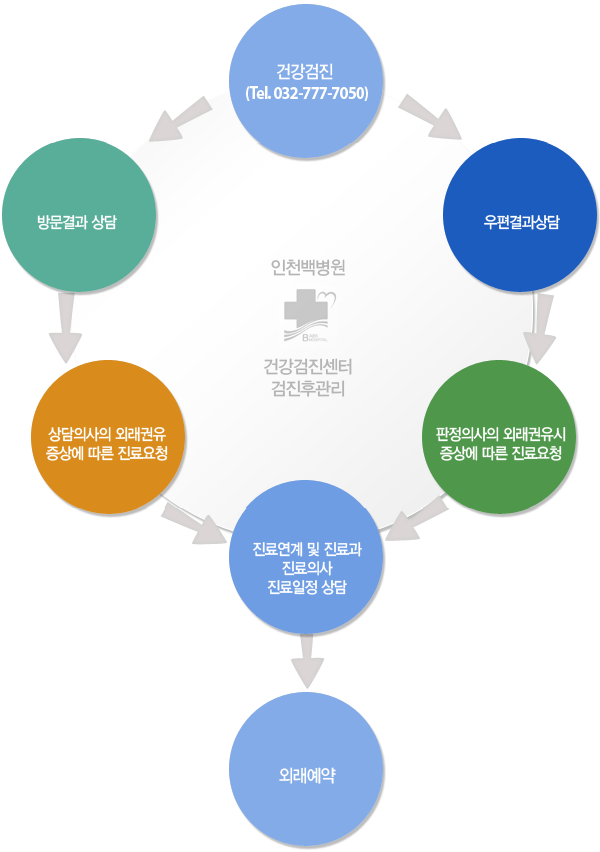| Basic and Blood Test |
Counseling and Body Measurement |
Health interview, consultation of results, height, weight, standard weight, waist circumference, body composition test |
○ |
○ |
○ |
○ |
| X-ray |
Chest X-ray(Front) |
○ |
○ |
○ |
○ |
| Ophthalmology Test |
visual acuity(L/R), corrected visual acuity (L/R) |
○ |
○ |
○ |
○ |
| Circulatory System Test |
Blood pressure, pulse rate, Electrocardiogram (EKG) |
○ |
○ |
○ |
○ |
| Complete Blood Count Test |
White blood cell count(WBC)
, Red blood cell count(RBC)
, Hemoglobin(Hb)
, Hematocrit (Hct)
, Mean corpuscular volume(MCV)
, Mean corpuscular hemoglobin (MCH)
, Mean corpuscular hemoglobin concentration(MCHC)
, Red cell distribution width(RDW)
, Platelet count(Platelet)
, Mean platelet volume(MPV)
, Platelet distribution width(PDW)
, Neutrophil(segment.Neutrophil)
, Lymphocyte(Lymphocyte)
, Monocyte(Monocyte)
, Eosinophil(Eosinophil)
, Basophil(Basophil)
|
○ |
○ |
○ |
○ |
| Thyroid Function Test |
Thyroid-stimulating hormone (TSH), Free thyroxine (Free T4), Thyroid cancer, Hypothyroidism |
○ |
○ |
○ |
○ |
| Hyperthyroidism Electrolyte Test |
Serum calcium(Ca)
, Serum phosphorus(P)
, Serum potassium(K)
, Serum sodium(Na)
, Serum chloride (Cl)
, Serum magnesium (Mg)
|
○ |
○ |
○ |
○ |
| Liver Function Test |
Total protein(Total protein)
, Albumin(Albumin)
, Globulin(Globulin)
, A/G Ratio
, Alkaline phosphatase(ALP)
, Total bilirubin(T-Bil)
, Direct bilirubin(D-Bil)
, Aspartate aminotransferase(S-GOT)
, Alanine aminotransferase(S-GPT)
, Gamma-glutamyl transferase(r-GTP)
|
○ |
○ |
○ |
○ |
| Pancreatic Function Test |
Amylase(Amylase) |
○ |
○ |
○ |
○ |
| Blood Glucose Test |
Fasting blood glucose (Glucose) |
○ |
○ |
○ |
○ |
| Glycated Hemoglobin(HbA1c) |
○ |
○ |
○ |
○ |
| Renal Function Test |
Blood urea nitrogen(BUN)
, Creatinine(Creatinine)
, Glomerular filtration rate(GFR)
|
○ |
○ |
○ |
○ |
| Cardiovascular Test |
Triglycerides(Triglyceride)
, Total cholesterol(T-Chol)
, HDL cholesterol(HDL-Chol)
, LDL cholesterol(LDL-Chol)
, Lactate dehydrogenase(LDH)
, Creatine kinase
, Creatine kinase-MB
, C-reactive protein(CRP)
|
○ |
○ |
○ |
○ |
| Hepatitis Test |
Hepatitis A(HAV Ab)
, Hepatitis B surface antigen (HBs Ag)
, Hepatitis B surface antibody(HBs Ab)
, Hepatitis C virus antibody(HCV Ab)
|
○ |
○ |
○ |
○ |
| Anemia Test |
Iron (Fe), Total iron-binding capacity(TIBC) |
○ |
○ |
○ |
○ |
| Musculoskeletal Test |
Rheumatoid factor (RA Factor), Uric acid(Uric acid) |
○ |
○ |
○ |
○ |
| Uric acid Immunoserological Test |
Human Immunodeficiency Virus(HIV), Venereal Disease Research Laboratory (VDRL) test (VDRL) |
○ |
○ |
○ |
○ |
| Gynecological Test |
Mammography(Mammography)*For those under 30 years old (optional) |
Female |
Female |
Female |
Female |
| Pap Smear Test(Pap Smear) |
Female |
Female |
Female |
Female |
| Urinalysis |
pH(pH) and 10 other factors |
○ |
○ |
○ |
○ |
Examinations with other diagnostic equipment |
Bone density test(DEXA) |
Female |
Female |
Female |
Female |
Tumor Marker Test |
Carcinoembryonic antigen(CEA)
, Carbohydrate antigen 19-9 (CA19-19)
, Alpha-fetoprotein(AFP)
Prostate-specific antigen (PSA)for males
Cancer antigen 125(CA 125), Cancer antigen 15-3(CA 15-3)for females,
|
○ |
○ |
○ |
○ |
| Genetic Disease Prediction Test |
GenoDoctor Genetic Test |
[For Males]
Thyroid Cancer/Colorectal Cancer/Liver Cancer/Stomach Cancer/Pancreatic Cancer/Bladder Cancer/Prostate Cancer/Chronic Lymphocytic Leukemia/Lymphoma/Prostate Cancer/Atrial Fibrillation/Osteoporosis/Type 2 Diabetes/Hypertension (High Blood Pressure)/Alzheimer's Disease/Male Pattern Baldness
|
- |
- |
○ |
○ |
|
[For Females]
Thyroid Cancer/Colorectal Cancer/Liver Cancer/Stomach Cancer/Pancreatic Cancer/Bladder Cancer/Lung Cancer/Chronic Lymphocytic Leukemia/Lymphoma/Breast Cancer/Ovarian Cancer/Atrial Fibrillation/Osteoporosis/Type 2 Diabetes/Hypertension (High Blood Pressure)/Alzheimer's Disease
|
| Medical Examinations with Equipment(Optional) |
Gastrointestinal Examination |
Upper Gastrointestinal Endoscopy (Sleep Endoscopy) |
○ |
○ |
○ |
○ |
| Colonoscopy (Sleep Endoscopy) |
- |
Select one |
Select two |
Select two |
| CT Scans |
Chest CT |
| Brain CT |
| Lumbar Spine CT |
| Cervical Spine CT |
| Cardiac CT |
| Ultrasound Examination |
Carotid Arteries |
- |
Select one |
Select one |
Select Three |
| Breast Ultrasound - For females |
| Prostate Ultrasound - For males |
| Thyroid Ultrasound |
| Abdominal Ultrasound |
○ |
○ |
○ |
○ |
| MRI or MRA |
Lumbar Spine MRI |
- |
- |
Select one |
Select one |
| Cervical Spine MRI |
| Brain MRI |
| Brain MRA |
| MRI of Shoulder or Knee (Choose 1) |






